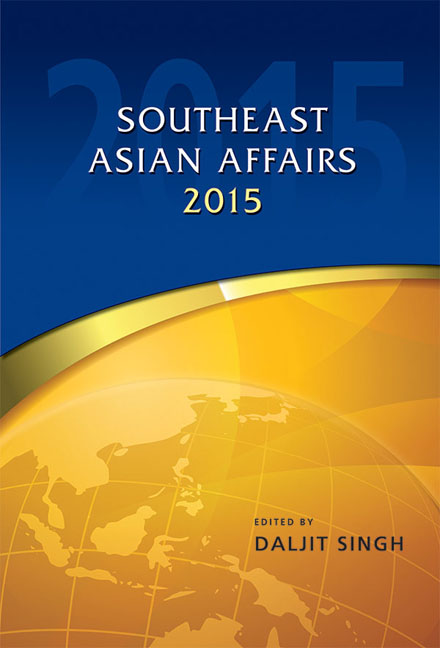Book contents
- Frontmatter
- Contents
- Foreword
- Introduction
- Acknowledgements
- THE REGION
- BRUNEI DARUSSALAM
- CAMBODIA
- INDONESIA
- LAOS
- MALAYSIA
- MYANMAR
- THE PHILIPPINES
- The Philippines in 2014: The More Things Stay the Same
- Typhoon Yolanda: The Politics of Disaster Response and Management
- SINGAPORE
- THAILAND
- TIMOR-LESTE
- VIETNAM
Typhoon Yolanda: The Politics of Disaster Response and Management
from THE PHILIPPINES
Published online by Cambridge University Press: 19 May 2017
- Frontmatter
- Contents
- Foreword
- Introduction
- Acknowledgements
- THE REGION
- BRUNEI DARUSSALAM
- CAMBODIA
- INDONESIA
- LAOS
- MALAYSIA
- MYANMAR
- THE PHILIPPINES
- The Philippines in 2014: The More Things Stay the Same
- Typhoon Yolanda: The Politics of Disaster Response and Management
- SINGAPORE
- THAILAND
- TIMOR-LESTE
- VIETNAM
Summary
Introduction
On 8 November 2013, typhoon Yolanda (internationally referred to as Haiyan), the strongest recorded typhoon ever to make landfall hit central Philippines, with wind speeds of more than 300 km/hour and storm surges of over four metres. Yolanda's impact was massive. It passed through 171 cities and municipalities in fourteen provinces in the country leading to an estimated 6,300 deaths, over a thousand people missing, around 1.5 million families (around 7.5 million individuals) displaced, and in all affecting 3.4 million families (about 16 million people) and damaging or destroying a million homes.
Experts opine that in some ways the impact of Yolanda was greater than the Haiti earthquake in terms of shelter damage (affecting about 475,000 people in 95,000 households) or the 2004 tsunami in terms of total number of people affected (about 2.3 million). Yolanda's total economic impact, estimated to reach US$10 billion in damages, was considered one of the top two most destructive disasters in the world during 2013.
The enormity of the disaster overwhelmed the administration of President Benigno Aquino whose response during the first few days of the crisis was widely criticized. The local governments of most of the affected areas, particularly Tacloban City, which suffered the most devastation, were caught unaware and took some time to get back on their feet and start organizing relief response. Meanwhile, haunting images broadcast internationally by the global media galvanized an unprecedented international response for relief and aid. However, due to logistical challenges, aid items took time to reach the ground. The Philippine Government, in partnership with national and international humanitarian actors, led the massive efforts to clear the roads, re-establish power systems and provide a range of life-saving humanitarian support to millions of people.
While progress could be seen and the focus had shifted from relief to recovery and rehabilitation a year after the typhoon, much remained to be done in terms of infrastructure, social services, resettlement and livelihood. In fact as of November 2014, many of the affected still lived in temporary shelters as only about 2,000 of the 205,000 permanent homes needed had been built. Meanwhile, replanting of the 33 million coconut trees could not be done immediately because of the huge task of clearing debris. In short, the level of recovery and reconstruction tasks ahead is enormous.
- Type
- Chapter
- Information
- Southeast Asian Affairs 2015 , pp. 277 - 302Publisher: ISEAS–Yusof Ishak InstitutePrint publication year: 2015



